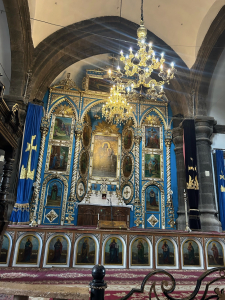Two Ways of Seeing
Roots of Armodoxy: Two Ways of Seeing
Two earthquakes, less than a year apart, with relative same intensity were recorded in the 1980’s. I was indirectly and directly at both of these. The first took place in a town called Spitak in Armenia. Close to 50,000 people perished. In a country of 3 million people, this means 1.7% of the population was wiped out in this single event. Along with Armenians throughout the world, I was involved in a massive fundraising effort to bring relief and humanitarian aid to the area.
To the second earthquake I had a front row seat. It was during the World Series – a special series that pitted the two Bay Area teams, the San Francisco Giants and the Oakland Athletics, against one another. The ground rumbled, and we found ourselves in the Loma Prieta quake, registering 6.9 magnitude on the Richter scale. The differences in the loss of life was remarkable. There was extensive damage to infrastructure, and life was disrupted for a while, but in the end sixty-three people had perished (compared to 50,000 in Armenia the winter before),
On the first anniversary of the Spitak quake, orders came from the top, the Catholicos of All Armenians, that we would solemnly observe the anniversary with requiem services throughout the world. The day was somber indeed, with reruns of video clips and reprints of articles and photos to forever forge the images in our mind.
On the first anniversary of the Bay Area quake, the atmosphere was completely festive! The community got together to celebrate the life that was spared! There were street parties and festivals proclaiming the win over something so tragic, celebrating their re-birth as a community.
The difference in the commemorations explains outlook and understanding of a population, much like the way we describe the same glass as being either half full or half empty. In the case of Gyumri, the sadness continued for years, in fact, decades later the effects of the earthquake are still felt. The dome of the church which fell during the quake is still sitting on the floor as a reminder. It sits there so that it is unavoidable, that is, you have to confront and acknowledge the past as you enter and exit the city. In so doing, a license for victimization is given. There is confusion. Instead of understanding their predicament logically, people revert to fatalistic answers, such as, “It is God’s will that I suffer.”
What I’m describing here can be seen in as comparison between the Old and New Testaments of the Bible. In the Old Testament we read stories – memories – that pit people against one another. The concept of God playing favorites with one people over another is pronounced and remembered throughout its pages. Jesus came to end that. His message was to everyone. Remember the Transfiguration. The point of Moses and Elijah being there was that Jesus is the fulfillment of the law and the prophets. “The Kingdom of God is at hand,” is how Jesus entered on the scene and the even greater news he had to give was that the Kingdom was accessible by everyone – young and old, regardless of race or nationality. With his proclamation he moved the model away from fatalism, back to self-determination. “To hear the word of God, and do it.” It’s about Faith being action, not a history lesson.
Baptism is the “Born Again” experience in the Armenian Church. It’s a fresh start, where the past is left behind. The “curse” of the memory is dropped. Memory serves to heal. Christianity is about celebrating the today. The past can be honored and revered but is not a place to live. The difference between a happy or festive expression and a sad expression is not merely an optimistic vs. pessimistic view of the world, it is an acknowledgement that God is with you, that the new day brings with it a new life.
We pray from the Book of Hours of the Armenian Church a morning prayer bringing in the new day, “We thank you O Lord our God, who granted us restful sleep in peace. Grant us to pass the remainder of the day in peace. Strengthen and guard us through the days of our lives, so that we live our lives with pure behavior and reach the peaceful haven in eternal life, by the grace and mercy of our Lord and Savior Jesus Christ. Amen.



